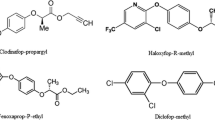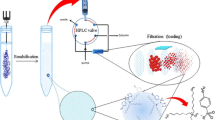Abstract
In the present study, a rapid, simple, and highly efficient sample preparation method based on ion-pair air-assisted liquid–liquid microextraction using a low-density extraction solvent followed by high performance liquid chromatography–diode array detection has been developed for the extraction, preconcentration, and determination of three phthalic acids (phthalic acid, iso-phthalic acid, and terephthalic acid) in aqueous samples. In this method, a mixture of tri-butyl amine (as an ion-pair reagent) and toluene (as an extraction solvent) is transferred into an aqueous sample solution. Fine organic solvent droplets are formed by aspirating and dispersing of the mixture via syringe needle. After that, the formed ion-pairs are extracted into toluene, and after centrifuging, the obtained collected phase is transferred into a microtube and is evaporated to dryness under a stream of nitrogen at room temperature. The residue is re-dissolved in mobile phase and injected into the separation system for analysis. Under the optimum extraction conditions, the method showed low limits of detection and quantification between 0.09–0.24 and 0.29–0.78 ng mL−1, respectively. Extraction recoveries and enrichment factors were from 88 to 98 % and 443 to 491, respectively. Relative standard deviations for the extraction of 5 ng mL−1 of each analyte were less than 8.4 % for intra-day (n = 6) and inter-days (n = 5) precisions. Finally, different aqueous samples were successfully analyzed using the proposed method, and the target analytes were determined in some of them at ng mL−1 level.







Similar content being viewed by others
Abbreviations
- AALLME:
-
Air-assisted liquid–liquid microextraction
- DAD:
-
Diode array detection
- DLLME:
-
Dispersive liquid–liquid microextraction
- EG:
-
Ethylene glycol
- EU:
-
European Union
- HPLC:
-
High performance liquid chromatography
- LLE:
-
Liquid–liquid extraction
- LPME:
-
Liquid-phase microextraction
- MRL:
-
Maximum residue level
- PET:
-
Poly (ethylene terephthalate)
- SPE:
-
Solid-phase extraction
- SPME:
-
Solid-phase microextraction
- TPA:
-
Terephthalic acid
- USAEME:
-
Ultrasound-assisted emulsification microextraction
- VALLME:
-
Vortex-assisted liquid–liquid microextraction
References
Baner A, Brandsch J, Franz R, Piringer O (1996) Migration of ethylene terephthalate oligomers from roasting bags into olive oil. Food Addit Contam 13:587–601
Begley TH, Hollifield HC (1990) High-performance liquid chromatographic determination of migrating poly(ethylene terephthalate) oligomers in corn oil. J Agric Food Chem 38:145–148
Begley TH, Dennison JL, Hollifield HC (1990) Migration into food of polyethylene terephthalate (PET) cyclic oligomers from PET microwave susceptor packaging. Food Addit Contam 7:797–803
Bianchi F, Careri M, Mangia A, Mattarozzi M, Musci M (2008) Experimental design for the optimization of the extraction conditions of polycyclic aromatic hydrocarbons in milk with a novel diethoxydiphenylsilane solid-phase microextraction fiber. J Chromatogr A 1196:41–46
Choodum A, Thavarungkul P, Kanatharana P (2007) Acetaldehyde residue in polyethylene terephthalate (PET) bottles. J Environ Sci Health Part B 42:577–583
Commission Regulation (EU) No 10/2011 of 14 January 2011 on plastic materials and articles intended to come into contact with food. Off. J. Eur. Union L12/1–L12/89 (2011).
Cooper I (2007) Plastics and chemical migration into food. In: Chemical migration and food contact materials. Ed. by Karen A. CRC Press, New York
Cunha SC, Fernandes JO, Oliveira MBPP (2009) Fast analysis of multiple pesticide residues in apple juice using dispersive liquid–liquid microextraction and multidimensional gas chromatography–mass spectrometry. J Chromatogr A 1216:8835–8844
Dabrowska A, Borcz A, Nawrocki J (2003) Aldehyde contamination of mineral water stored in PET bottles. Food Addit Contam 20:1170–1177
EC, Commission Directive No. 97/48/EC of 29 July 1997 amending for the second time Council Directive 82/711/EEC laying down the basic rules necessary for testing migration of the constituents of plastic materials and articles intended to come into contact with foodstuffs. Off. J. Eur. Communities L 222 (1997) 10–15
European Union Commission Directive 2002/72/EC, 2005–1895–EC
Farajzadeh MA, Dj D, Afshar Mogaddam MR, Nourozi J (2012) Determination of phthalate esters in cow milk samples using dispersive liquid–liquid microextraction coupled with gas chromatography followed by flame ionization and mass spectrometric detection. J Sep Sci 35:742–749
He Y, Lee HK (1997) Liquid-phase microextraction in a single drop of organic solvent by using a conventional microsyringe. Anal Chem 69:4634–4639
Hou L, Lee HK (2002) Application of static and dynamic liquid-phase microextraction in the determination of polycyclic aromatic hydrocarbons. J Chromatogr A 976:377–385
Jeannot MA, Cantwell FF (1996) Solvent microextraction into a single drop. Anal Chem 68:2236–2240
Kashtock M, Breder CV (1980) Migration of ethylene glycol from polyethylene terephthalate bottles into 3 % acetic acid. J AOAC 63:168–172
Kim DJ, Lee KT (2012) Determination of monomers and oligomers in polyethylene terephthalate trays and bottles for food use by using high performance liquid chromatography–electrospray ionization mass spectrometry. Poly Test 31:490–499
Kim H, Gilbert SG, Johnson JB (1990) Determination of potential migrants from commercial amber polyethylene terephthalate bottle wall. Pharm Res 7:176–179
KOREA FDA. Food Code, 2010, Part 7. Standards and specifications for articles, containers and packages
Lee J, Lee HK (2011) Fully automated dynamic in-syringe liquid-phase microextraction and on-column derivatization of carbamate pesticides with gas chromatography/mass spectrometric analysis. Anal Chem 83:6856–6861
Life Hygiene Bureau of Japanese Welfare Ministry (LHBJWM) Food hygiene law, part 3. Specifications and standards for articles, containers and packages (1999). pp. 1048–1084
Liu H, Dasgupta PK (1996) Analytical chemistry in a drop. Solvent extraction in a microdrop. Anal Chem 68:1817–1821
Monteiro M, Nerín C, Reyes FGR (1996) Determination of UV stabilizers in PET bottles by high performance-size exclusion chromatography. Food Addit Contam 13:575–586
Mutsuga M, Kawamura Y, Sugita–Konishi Y, Hara–Kudo Y, Takatori K, Tanamoto K (2006) Migration of formaldehyde and acetaldehyde into mineral water in polyethylene terephthalate (PET) bottles. Food Addit Contam 23:212–218
Park HJ, Lee YJ, Kim MR, Kim KM (2008) Safety of polyethylene terephthalate food containers evaluated by HPLC, migration test, and estimated daily intake. J Food Sci 73:T 83–T 89
Rezaee M, Assadi Y, Hosseini MRM, Aghaeem E, Ahmadi F, Berijani S (2006) Determination of organic compounds in water using dispersive liquid–liquid microextraction. J Chromatogr A 1116:1–9
Sanagi MM, Abbas HH, Ibrahim WAW, Aboul-Enien Y (2012) Dispersive liquid–liquid microextraction method based on solidification of floating organic droplet for the determination of triazine herbicides in water and sugarcane samples. Food Chem 133:557–562
Schmid P, Kohler M, Meierhofer R, Luzi S, Wegelin M (2008) Does the reuse of PET bottles during solar water disinfection pose a health risk due to the migration of plasticisers and other chemicals into the water? Water Res 42:5054–5060
Turner C, Mathiasson L (2000) Determination of vitamins A and E in milk powder using supercritical fluid extraction for sample clean-up. J Chromatogr A 874:275–283
USFDA. Code of federal regulation. 2010. Chapter 21, Parts 170–199
Wang P, Yang X, Wang J, Cui J, Dong AJ, Zhao HT, Zhang LW, Wang ZY, Xu RB, Li WJ, Zhang YC, Zhang H, Jing J (2012) Multi-residue method for determination of seven neonicotinoid insecticides in grains using dispersive solid-phase extraction and dispersive liquid–liquid micro-extraction by high performance liquid chromatography. Food Chem 134:1691–1698
Wegelin M, Canonica S, Alder AC, Marazuela D, Suter MJF, Bucheli TD, Heafliger OP, Zenobi R, McGuigan KG, Kelly MT, Ibrahim P, Larroque M (2001) Does sunlight change the material and content of polyethylene terephthalate (PET) bottles? Journal of Water Supply Research Technology AQUA 50:125–133
Yang ZH, Liu DH, Zhao WT, Wu T, Zhou ZQ, Wang P (2013) Low-density solvent-based vortex-assisted surfactant-enhanced emulsification liquid–liquid microextraction and its application. J Sep Sci 36:916–922
Yebra–Pimentel I, Martinez–Carballo E, Regueiro J, Simal–Gandara J (2013) The potential of solvent-minimized extraction methods in the determination of polycyclic aromatic hydrocarbons in fish oils. Food Chem 139:1036–1043
Zhu L, Ee HK, Zhao L, Lee HK (2002) Analysis of phenoxy herbicides in bovine milk by means of liquid–liquid–liquid microextraction with a hollow-fiber membrane. J Chromatogr A 963:335–343
Acknowledgments
The authors thank the Research Council of University of Tabriz for financial support.
Funding
Mir Ali Farajzadeh has received research grants from the University of Tabriz.
Conflict of Interest
Mir Ali Farajzadeh declares that he has no conflict of interest. Mohammad Reza Afshar Mogaddam declares that he has no conflict of interest. Hamid Reza Shahbaazi declares that he has no conflict of interest. This article does not contain any studies with human or animal subjects.
Author information
Authors and Affiliations
Corresponding author
Rights and permissions
About this article
Cite this article
Farajzadeh, M.A., Afshar Mogaddam, M.R. & Shahbaazi, H.R. Ion-Pair-Based Air-Assisted Liquid–Liquid Microextraction for the Extraction and Preconcentration of Phthalic Acids from Aqueous Samples. Food Anal. Methods 9, 1096–1105 (2016). https://doi.org/10.1007/s12161-015-0279-3
Received:
Accepted:
Published:
Issue Date:
DOI: https://doi.org/10.1007/s12161-015-0279-3




